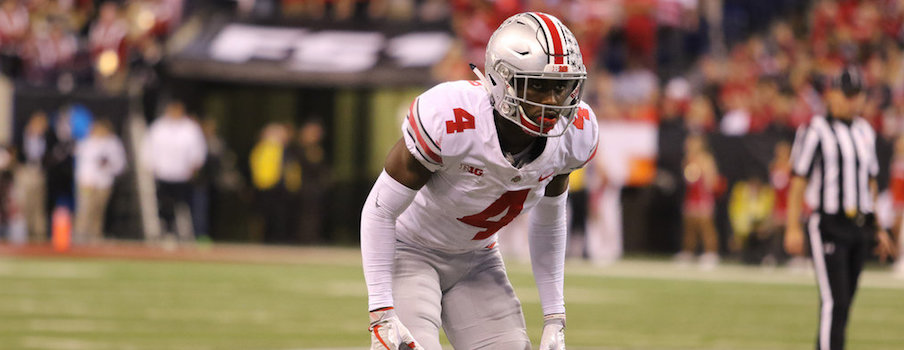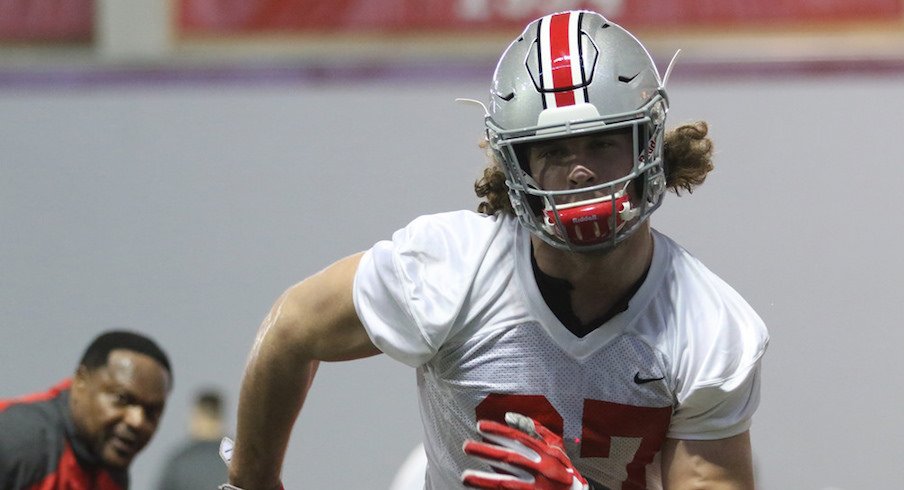When you think of a college football player and when he improves the most, the most logical answer is often the jump from freshman to sophomore year.
It's an easy assumption to make, especially when you look at the likes of both Joey and Nick Bosa, Ezekiel Elliott, Sam Hubbard and others.
However, as one of Ohio State's most experienced coaches said Wednesday, he believes players can make the biggest jump in personal growth on the field from sophomore to junior year.
"It's two-to-three is really the biggest jump. First year, you are trying to learn the system and learn how we do it. Second, you go and play with those techniques and third year, you are trying to improve that much, each time he walks on the field," said Ohio State defensive line coach Larry Johnson, signifying minimal daily improvement by measuring the distance between his thumb and pointer finger. "You have a guy like Nick who has some elite skill sets, but at the same time, there is so much room for improvement. Those improvements are just that small. Your job as a coach is to find the moments where you can improve that much. Every day is like that and Nick has taken that to heart."
Bosa, much like his older brother Joey, made a great leap from his first year to his second, earning conference defensive lineman of the year honors in 2017 despite not being a full-time starter. He isn't the only member of the 2016 class, however, that could make a greater impact in year three as a Buckeye.
Jordan Fuller enters the 2018 season as Ohio State's clear-cut starter at strong safety, after a year in which he battled veteran Erick Smith for playing time. Now a junior, he appears poised for a breakout season with Ohio State defensive coordinator Greg Schiano going as far as to say Fuller could be an All-American.
His new position coach Alex Grinch said Wednesday that in his experience, he believes a player's development is more specific to the individual player, but added special teams experience and time in the weight room need to be taken seriously.

"I think a lot of times it stems from what takes place over that calendar year. For some guys, the benefit of playing on special teams or something like that, to get on the field and be in the arena, you get a feel for a game day and waht that can then lead to the following year," Grinch said. "So if that was your role as a freshman, can that lead to a comfort level going into year two where you have a chance at that point to see your role expand?
"For other guys, it’s critical if they can just focus on the physical aspect of things — the athletic aspect of things, getting comfortable with being a college freshman and adapting to this level," he added. "And they benefit from not having those Saturdays to worry about. I think it’s very specific to the individual.”
That kind of development appears to have taken place already for a guy like Fuller, who enters his third year in the program as one of the clear leaders of the defense.
"He has an understanding of the defense and I’ll use the term that he’s a master of the defense. He can fix issues. He can get other guys right from an alignment and call standpoint and he has the confidence to do so. and that comes from game reps," Grinch said. "But when you add all those things up, the physical tools, the athletic tools and then the mental aptitude, you’re talking about a guy is an established starter and a guy we’re looking forward to come fall.”
While some players burst onto the scene as freshmen, others take more time to develop, as Grinch hinted at. During a sophomore campaign, while players like Nick and Joey Bosa make obvious strides, others seem to drop in terms of production.
A hamstring injury and the emergence of J.K. Dobbins saw Mike Weber's numbers drop in his third year in the program as a redshirt sophomore. However, his speed was noticeably improved from 2016 to 2017, and his position coach Tony Alford said he doesn't believe in the "sophomore slump" theory. What he stays wary of, however, is making sure a player coming off of a successful season doesn't get complacent, regardless of their remaining eligibility.
"I don’t know if I buy into that quite frankly. What you have to guard against is when a guy has great success as a freshman, what you have to guard against is if he becomes complacent and he thinks he’s arrived and he’s got it figured out," Alford said. "That’s the same thing with a guy going from sophomore to junior year. You’ve got to fight the complacency of, ‘I’ve got this, Coach.’ Are you still as energetic, are you still as intentional about your preparation on and off the field as far as in the film room and things of that nature as you were when you weren’t playing a lot?
"You were trying to prove something that, ‘Hey, I’m capable and able to play.’ Once you’ve done that, are you still as intentional about how you prepare moving forward?”
Overall, Alford said that as long as a player has faith in his coach, and the coach shows a player a plan of how they plan on developing the athlete, then regardless of their eligibility, the growth and maturity in their game will eventually come.
“I think if you build a rapport with your player and they know that you have their best interest at hand and you care enough about them, when you ask them to do something they’re going to do it, especially when you can say, ‘Here’s why.’ You can show justification by saying, ‘Here’s where you’re at. Here’s where I want to get you,’" Alford said. "So here’s what we have to go and do. You want to get from A to B, and we’re going to fill in that gap. How are we going to fill in that gap?’ You have to be able to show them. It’s just a kind of maturation of building through the system and the offense.”


